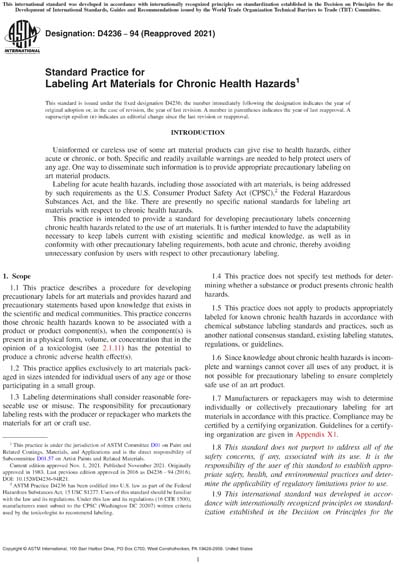Most recent
ASTM D4236-94(2021)
Standard Practice for Labeling Art Materials for Chronic Health Hazards
1.1This practice describes a procedure for developing precautionary labels for art materials and provides hazard and precautionary statements based upon knowledge that exists in the scientific and medical communities. This practice concerns those chronic health hazards known to be associated with a product or product component(s), when the component(s) is present in a physical form, volume, or concentration that in the opinion of a toxicologist (see 2.1.11) has the potential to produce a chronic adverse health effect(s).
1.2This practice applies exclusively to art materials packaged in sizes intended for individual users of any age or those participating in a small group.
1.3Labeling determinations shall consider reasonable foreseeable use or misuse. The responsibility for precautionary labeling rests with the producer or repackager who markets the materials for art or craft use.
1.4This practice does not specify test methods for determining whether a substance or product presents chronic health hazards.
1.5This practice does not apply to products appropriately labeled for known chronic health hazards in accordance with chemical substance labeling standards and practices, such as another national consensus standard, existing labeling statutes, regulations, or guidelines.
1.6Since knowledge about chronic health hazards is incomplete and warnings cannot cover all uses of any product, it is not possible for precautionary labeling to ensure completely safe use of an art product.
1.7Manufacturers or repackagers may wish to determine individually or collectively precautionary labeling for art materials in accordance with this practice. Compliance may be certified by a certifying organization. Guidelines for a certifying organization are given in Appendix X1.
1.8This standard does not purport to address all of the safety concerns, if any, associated with its use. It is the responsibility of the user of this standard to establish appropriate safety, health, and environmental practices and determine the applicability of regulatory limitations prior to use.
1.9This international standard was developed in accordance with internationally recognized principles on standardization established in the Decision on Principles for the Development of International Standards, Guides and Recommendations issued by the World Trade Organization Technical Barriers to Trade (TBT) Committee.
ASTM International [astm]

